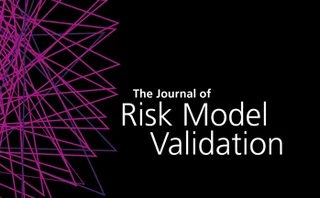Stress-testing
Banks tout machine learning amid regulatory concerns
Machine learning being used to build challenger models for model validation
CCAR feedback prompts banks to improve governance
Dual reviews of stress testing models and scenarios becoming the norm
UC’s Bookstaber urges use of agent-based models
Pension fund’s CRO says buy side should go beyond stress tests and try to model systemic risk
Forward ordinal probability models for point-in-time probability of default term structure: methodologies and implementations for IFRS 9 expected credit loss estimation and CCAR stress testing
This paper proposes an ordinal model based on forward ordinal probabilities for rank outcomes.
CCP stress testing gets real
Quants propose technique to generate effective, plausible CCP stress-testing scenarios
Extremely (un)likely: a plausibility approach to stress testing
CCP’s risk managers propose a framework for generating extreme but plausible stress scenarios
UK proposes gold plating of liquidity risk rules
Cashflow mismatch risk framework aims to plug holes in Basel Committee's liquidity coverage ratio
Investment funds would magnify a liquidity crisis – BoE
Bank of England’s first stress simulation suggests corporate spreads would gap 41bp on 1% redemptions
CCAR helps identify op risks, banking experts say
Banks forced to consider link between risks and macroeconomic factors
US Treasury stance on CCAR a return to ‘bad old days’
Overhaul would kill test failed by eight banks in past three years
The untapped potential of stress tests
Quants propose technique to include stress testing in portfolio allocation
Stress hedging in portfolio construction
Bilgili, Ferconi and Ulitsky propose a constrained portfolio optimisation approach incorporating stress scenarios
New light cast on shadow bank risk
PLS-SEM model could test assumptions on shadow banks’ risk role
Model risk falls under the CCAR microscope
Fed using qualitative reviews to test compliance with SR 11-7
Forecasting scenarios from the perspective of a reverse stress test using second-order cone programming
This paper proposes a model for forecasting scenarios from the perspective of a reverse stress test using interest rate, equity and foreign exchange data.
Volatility of IFRS 9 loss estimates alarms lenders
Accounting model outputs wildly out of sync with those used to calculate regulatory capital requirements
Why multi-asset managers shouldn’t count on the past
Risk models are backward-looking but history won’t repeat itself
ECB rate risk stress test renews fears over internal models
Banks alarmed by short timeline and opaque supervisory use of IRRBB stress test
White paper: The financial paradigm shift
White paper: FactSet
A network model for central counterparty liquidity risk stress testing under incomplete information
The authors put forth a realistic network model that maximizes the use of data available to a CCP in order to simulate credit default contagion.
Dodd-Frank rollback targets asset manager stress tests
Amended Financial Choice Act eliminates stress tests for funds, lobbyist claims
Rating momentum in the macroeconomic stress testing and scenario analysis of credit risk
This paper focuses on the corporate stress testing models for credit risk.
Uniform EU stress test backed by CCPs and banks
Second Esma test will apply three scenarios to 17 clearing houses, but concerns remain
A model combination approach to developing robust models for credit risk stress testing: an application to a stressed economy
This paper uses a model combination approach to develop robust macrofinancial models for credit risk stress testing.


















